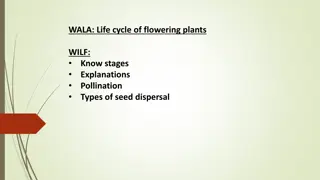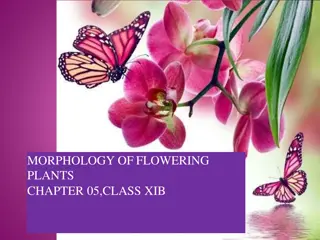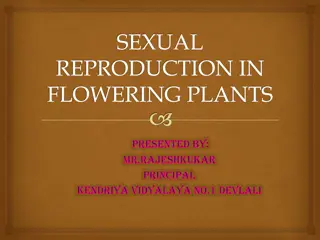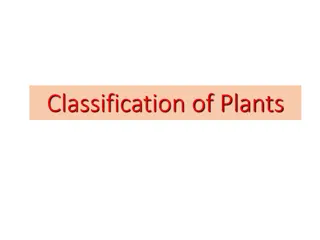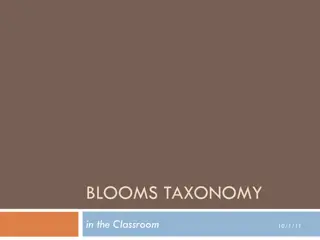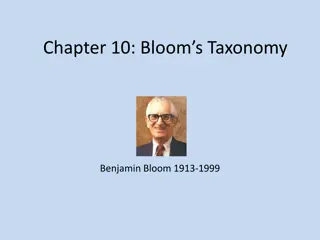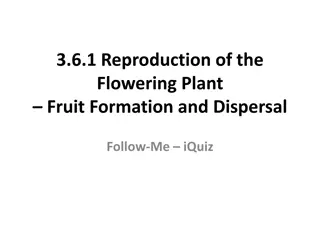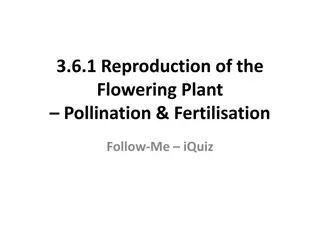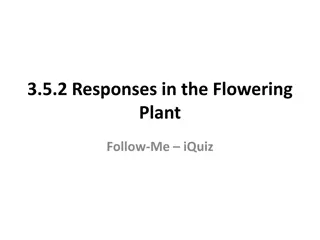Understanding Plant Taxonomy: A Comprehensive Overview of Flowering Plants
Plant taxonomy involves the study of various characteristics such as morphology, anatomy, photochemistry, cytology, and palynology. It plays a crucial role in the classification and understanding of plants. This content explores the principles of flowering plants, university vision and mission statements, and the visions of the College of Science and Botany Department. Additionally, it delves into the significance of plant morphology, particularly in terms of vegetative and floral characteristics.
Download Presentation

Please find below an Image/Link to download the presentation.
The content on the website is provided AS IS for your information and personal use only. It may not be sold, licensed, or shared on other websites without obtaining consent from the author. Download presentation by click this link. If you encounter any issues during the download, it is possible that the publisher has removed the file from their server.
E N D
Presentation Transcript
PRINCIPALS OF FLOWERING PRINCIPALS OF FLOWERING PLANTS TAXONOMY PLANTS TAXONOMY BOT BOT 222 222 Dr. Najat Abdulwahab Bukhari Lecture 3
University Vision and Mission Vision: To be a world-class university and a leader in developing Saudi Arabia s knowledge economy Mission: To provide students with a quality education, conduct valuable research, serve the national and international societies and contribute to Saudi Arabia s knowledge economy through learning, creativity, the use of current and developing technologies and effective international partnership.
College of science vision and Mission Vision: To be a leader in basic science, its applications and culture to contribute to building the knowledge society. Mission: To offer study programs and developed research projects capable of providing knowledge and trained personnel through a stimulating environment for learning, creativity and scientific research with continuing quality to ensure optimal use of technology and general partnership. society with
Botany department Vision and Mission Vision: upgrading the academic and research to keep pace with scientific progress and requirements of society. Mission: Development of Academic process and develop scientific research through strategic planning and a clear vision for science and technology at the country level. As well as training of national cadres, and the introduction of a methodology developed to meet the different needs of society, and to serve the various research and developmental projects in the community
Plant taxonomy use many characters : Morphology Anatomy Photochemistry Cytology Palynology
Plant Morphology is the general term for the study of the morphology (physical form and external structure) of plants: 1. Vegetative characteristics: (leaves and stems). 2. Floral characteristics: ( Flower and inflorescence )
Flower is valuable in plant classification and taxonomy, It is considered one of the most important part of the plant in the plant classification process for the following reasons: 1. The flower is less affected by different environmental and climate conditions. 2. Contain many basic and obvious differences that distinguish the various plants . Therefore, plants are arranged into several Orders, families , Genus and species . For example: aquatic plants may be similar in outward appearance and internal structure, but differ in the composition of flowers and plants as well as xerosis and salt- loving plants.
3. The flower is a unique thing in the life of plants angiosperms ,as it is the axis that holds reproduction in organs in the flowering plants, and it s the key part of sexual reproduction
flower is regarded as a modified stem with shortened internodes and bearing, at its nodes, structures that may be highly modified leaves. Flowers may be attached to the plant in a few ways. If the flower has no stem but forms in the axil of a leaf, it is called sessile. When one flower is produced, the stem holding the flower is called a peduncle.
If the peduncle ends with groups of flowers, each stem that holds a flower is called a pedicel. The flowering stem forms a terminal end which is called the torus or receptacle. The parts of a flower are arranged in whorls on the torus. The four main parts or whorls (starting from the base of the flower or lowest node and working upwards) are as follows:
1. Calyx: the outer whorl of sepals; typically these are green, but are petal-like in some species. 2. Corolla: the whorl of petals, which are usually thin, soft and colored to attract animals that help the process of pollination. The coloration may extend into the ultraviolet, which is visible to the compound eyes of insects, but not to the eyes of birds.
1. Androecium : one or two whorls of stamens, each a filament topped by an anther where pollen is produced. Pollen contains the male gametes. 2. Gynoecium: one or more pistils. The female reproductive organ is the carpel: this contains an ovary with ovules (which contain female gametes). The sticky tip of the pistil, the stigma, is the receptor of pollen. The supportive stalk, the style becomes the pathway for pollen tubes to grow from pollen grains adhering to the stigma, to the ovules, carrying the reproductive material.
a bractis a modified leaf or leaf like part just below and protecting an inflorescence Bracts are often (but not always) different from foliage leaves, for example being smaller, larger, or of a different color or texture. http://upload.wikimedia.org/wikipedia/commons/thumb/4/43/Yellow-rattle_close_700.jpg/300px-Yellow-rattle_close_700.jpg Bracts are found in the front of the flower ( the part of flower facing the bracts is called Anterior Side ) and the other side Posterior Side .
bracteole or bractlet: a small bract that arises on a pedicel instead of subtending it. Bractlets can be 2 in dicotyledons, and one in monocots one which may be green or squamous They can differ from each other on where are inserted.
Receptacle is the thickened part of a stem from which the flower organs grow. It is often a shape of bulging disc or a rectangular or circular or in the platoon as the cruciferae family. When the receptacle elongate between the Corolla and calyx and its called Anthophore, and between the corolla and the stamen it is called Andero gynophore. Or elongate between Anderoecium and gynoecium it is called Gynophore. Receptacle contain glands to attract insects so the process of pollination and fertilization, nectar is a sugar syrup .
File:Ovary position.svg The receptacle (grey) in relation to the ovary (red) in three types of flowers: hypogynous (I), perigynous (II), and epigynous (III)
Why is the flower the most important parts of the plant in the classification process: The least part of the plant affected by different environmental and climate conditions. Contain many basic and obvious differences that distinguish the various plants (For example, aquatic plants may be similar in outward appearance and internal structure, but differ in the composition of its flowers to belong to different plant families).
The flower is a unique thing in the life of floral plants angiosperms and It is also the axis that holds the reproduction organs in the flowering plants. The center of plant reproduction as it is composed to ensure that sexual reproduction and fertilizing eggs .
Calyx: Is composed of a number of sepals may be rarely 2-3 or 4 in one specie the cruciferae family or 5 in most of the families. The calyx is the outermost whorl of a flower. Function: protection of the flower internal organs. Sepals are often green but sometimes it takes the petals colure ( Petaloid sepalous). The number of sepals often equal to the number of petals.
Sepals are often green but sometimes it takes the petals colure ( Petaloid sepalous). The number of sepals often equal to the number of petals. Sepals often form one ring, but it may sometimes be in two rings. sepals may be loose, as in roses and or it could be fused, as in peas. There pericalyceal called Epipetalous" as in the cotton flower or Malvavceae family. may be additional external
Calyx could stay on the receptacle and does not fall after the pollination and fertilization, in this case it is called presistant , as in the eggplant. Calyx could fall early when the flower opens, in this case it is called Cadocous as in the Poppy.
When the petals and sepals of a flower look similar they are called tepals. They both form Perianth. Sepals help in the process of spreading seed and fruit. In some cases specially in the tropical flowers the calyx is in the form of portfolio wrapped around a floral bud, and filled with water.
Calyx shapes: 1.Tubular




